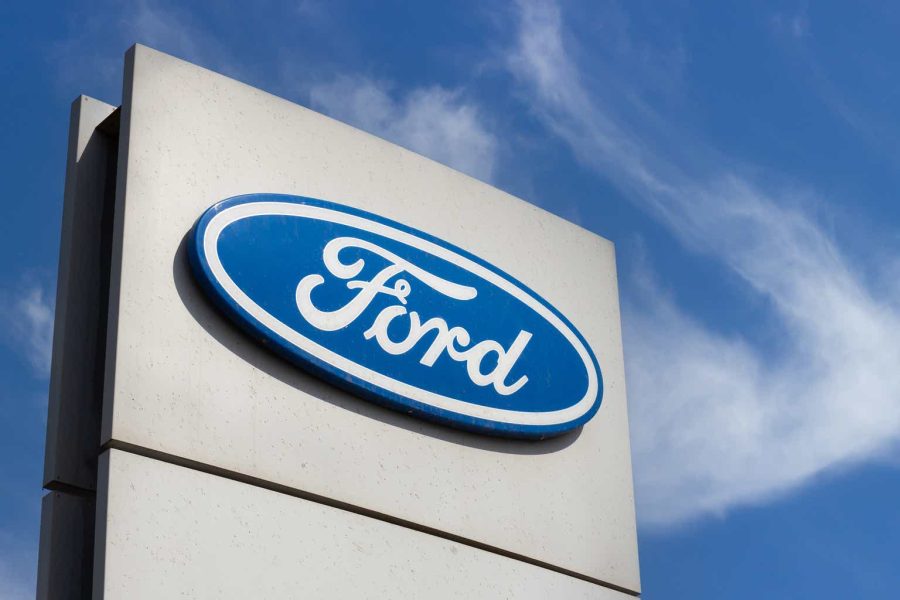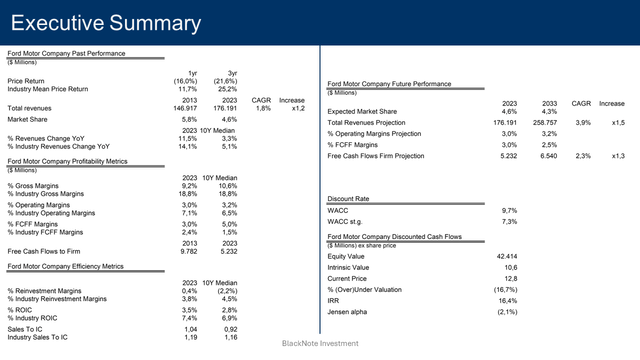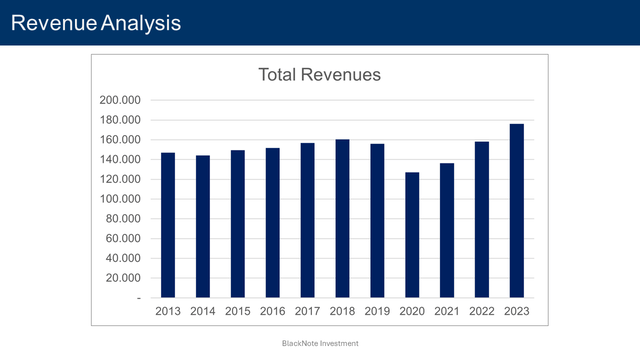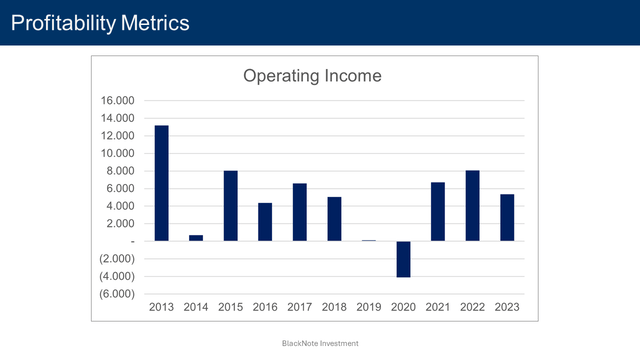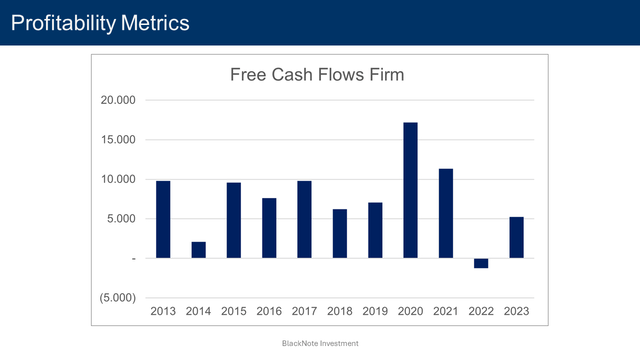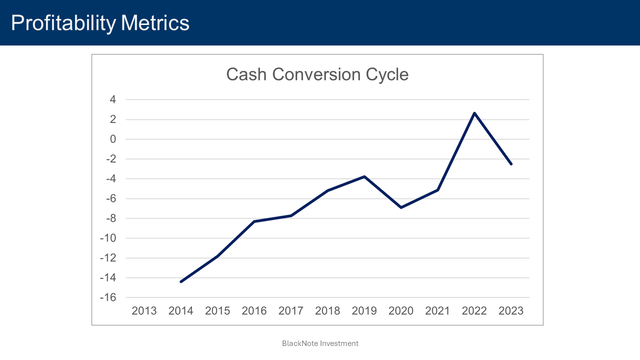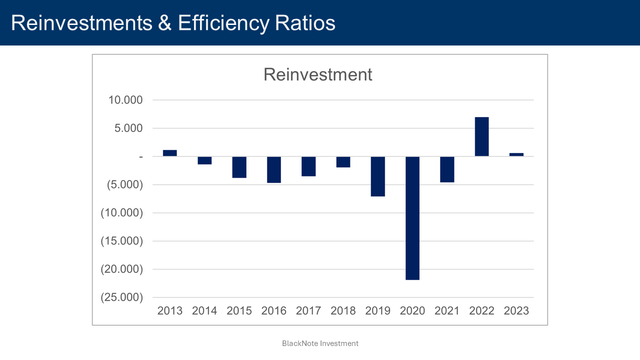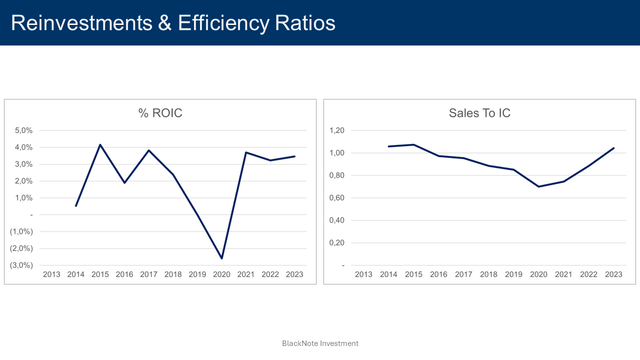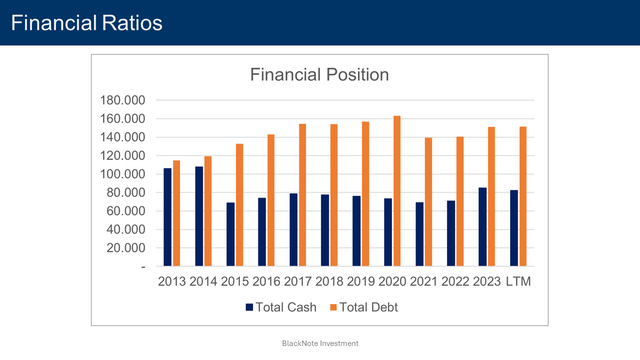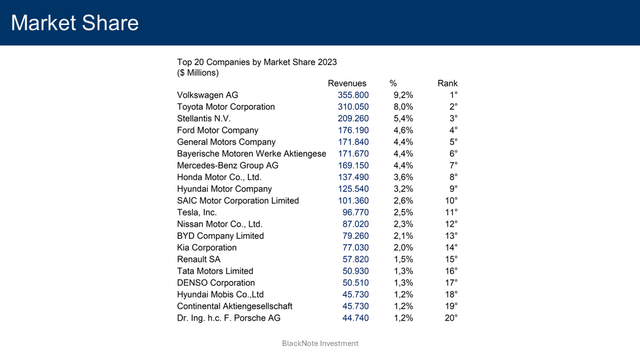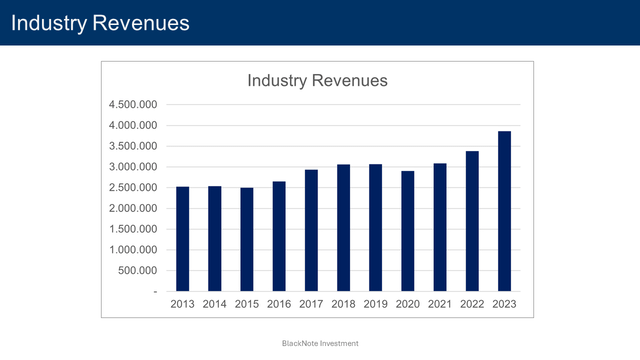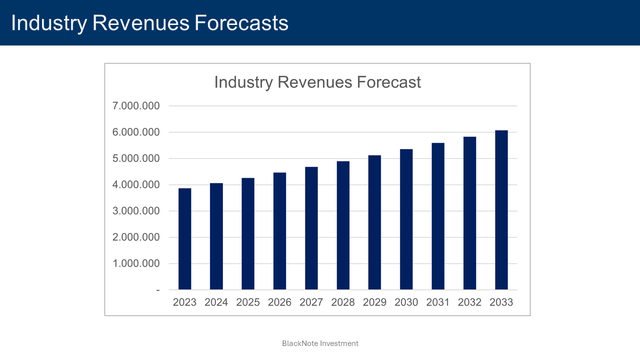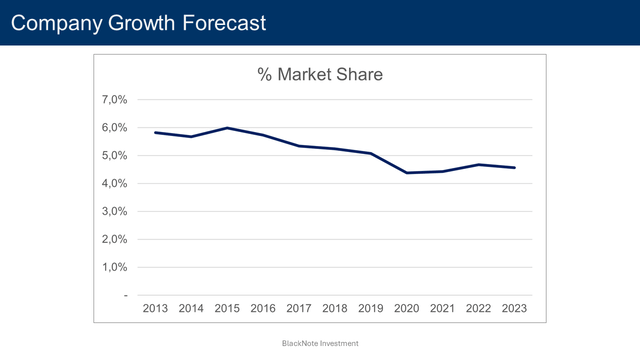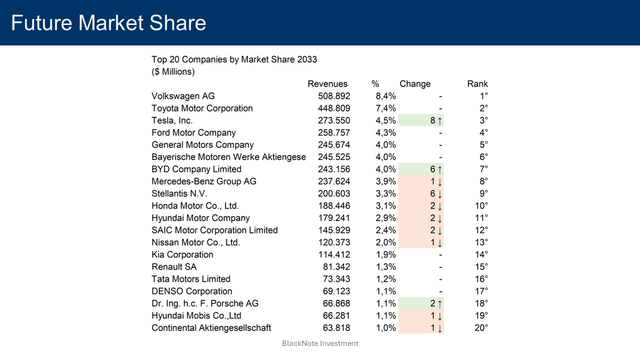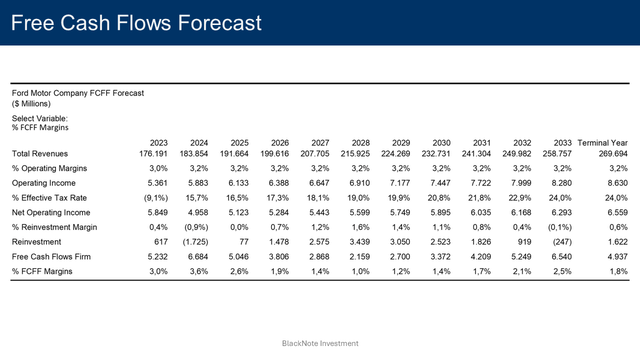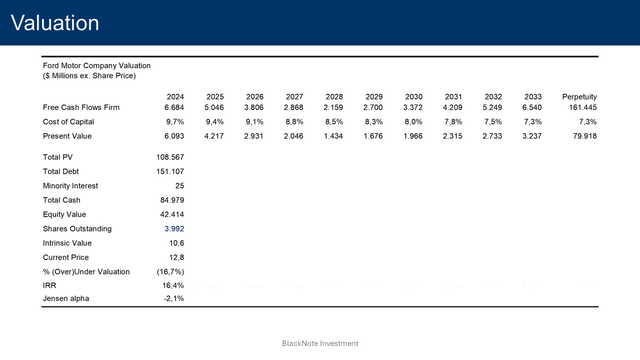Summary:
- Despite good Q2 EV sales, Ford Motor Company’s market share is expected to decrease as EV manufacturers dominate.
- Ford’s profitability is expected to remain stable, while free cash flow margins are expected to decrease as Ford will be forced to increase its reinvestment to remain competitive.
- At current prices, Ford’s risk-reward profile suggests slightly negative excess return potential.
Vera Tikhonova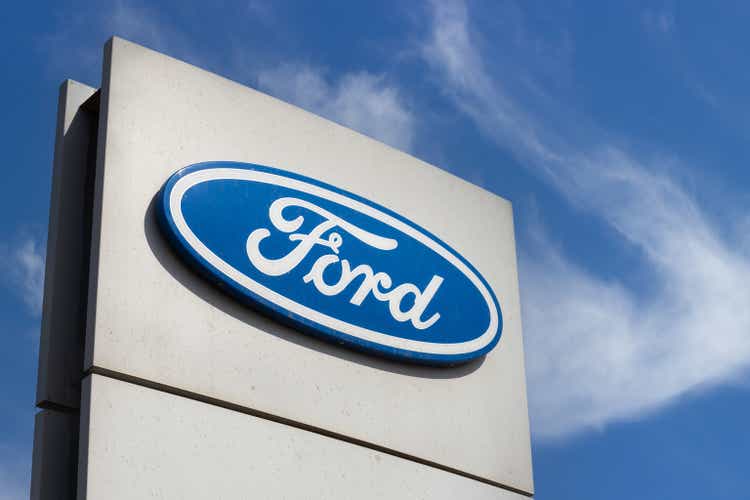
Executive Summary
Ford Motor Company (NYSE:F) stock is currently trading around its fair market price.
We expect Ford to shrink its market share in the foreseeable future, as prominent EV manufacturers like Tesla (TSLA) and BYD (OTCPK:BYDDF) will strengthen their market dominance further and erode the market share of legacy automakers.
At the same time, we expect the firm to maintain its historical profitability, while free cash flow margins are expected to decrease in the next 3 to 5 years, as Ford will be forced to increase its reinvestment to remain competitive, to then recover around the historical average by 2033.
At current prices, our assumptions suggest that Ford’s risk-reward profile has the potential to generate a slightly negative excess return (alpha -2.1%).
Q2 Sales Report
Ford just reported its Q2 sales figures, reporting a 1% sales increase year-over-over, primarily led by increases in truck sales, in particular the F-Series.
However, the most interesting news given the sluggish electric vehicle (“EV”) segment of the past year, is that year-over-year (“YOY”) EVs and hybrid sales increased 61% and 56%, respectively. This makes Ford the second best-selling brand of electric vehicles in the US, after Tesla.
Despite the company taking a step back from heavily investing in its EV segment, it’s clear that the market direction is towards electrification, especially in terms of growth opportunity and market share.
Revenue Analysis
As of the end of 2023, Ford’s total revenues stood at $176.2 billion, increasing by 11.5%, a slightly worse performance when compared to the YOY industry growth rate of 14.1%.
Despite the 2023 performance, over the past decade, the company’s median revenue growth rate was equal to 3.3%, again lower than the industry median growth rate of 5.1% for the same period.
As of the 2024 Q1, revenues grew 3.1% quarter on quarter.
Profitability Metrics
Ford’s operating margin was 3%, worse than the 2023 industry median value of 7.1%. The total operating profit was $5.4 billion, registering a whopping decrease of (33.6)% YOY.
Confirming the disappointing 2023, the median operating margin is equal to 3.2%, lower than the industry median value of 6.5% registered over the past decade.
The 2024 Q1 confirmed the firm’s historical profitability levels, with a 3.1% operating margin.
Considering Ford’s long-standing position as a legacy automaker, we comfortably expect the firm to maintain an operating margin around its historical median of 3.2% in the coming years.
Looking at other measures of profitability, in 2023 the gross margin sat at 9.2%, in line with the median value of 10.6%, while the free cash flow margin was 3%, worse than the past decade’s median value of 5%, but significantly better than the 10Y median industry value of 1.5%.
Despite the lower profitability when compared to the industry average, Ford has been able to deliver solid and consistent free cash flows to the firm (FCFF) through the years, equal to $5.2 billion in 2023.
The major contributor to firms’ ability to generate positive cash flows relies upon its excellent working capital management. From 2013 to 2023, Ford has repeatedly scored a negative cash conversion cycle (CCC), registering a 10Y median value of negative (6.6) days, while the median value for top automakers sits at 27.3 days.
The CCC ratio is a good metric to compare automakers’ ability to manage working capital as it measures the length of time it takes a firm to turn inventory investments into cash, obtained as average days of outstanding inventory and outstanding receivables minus average days of outstanding payables.
Firms with low CCC ratios have lower reinvestment needs in working capital, and thus higher free cash flows.
A negative CCC ratio implies that Ford’s working capital needs are indirectly entirely financed by suppliers, granting them longer payment periods than the period it takes for automakers to sell finished vehicles and collect cash from customers.
Reinvestment & Efficiency Ratios
Over the past decade, the median reinvestment margin of Ford stands at negative (2.2)%, comprising net capital expenditures, acquisitions, and changes in working capital. When treating R&D expenses as capital expenditures due to their long-term value generation, this figure adjusts to 1.1%.
In terms of efficiency, during the period 2013-2023, Ford boasts a median ROIC of 2.8% – compared to an industry median value of 6.9% – and a sales to invested capital ratio of 0.92, lower than the industry median value of 1.16.
Financial Ratios
Briefly dwelling on financial ratios, as of the most recent reporting period, the net cash position registers a negative value of $69 billion. However, Ford’s high indebtedness is due to its Ford Credit segment offering vehicle-related financial services to its customers, which is a full-fledged financial firm within Ford. Hence, debt should be treated as “raw materials” to run its business.
The interest coverage ratio sits at 3.7 as of the LTM, while the current ratio and the debt-to-equity ratio sit at 1.17 and 3.5, respectively – 2013-2023 median values of 1.2 and 4.33 respectively.
Market Share and Competitors Analysis
Ford, with its $176.2 billion in revenues in 2023, has established a good presence in the automobile industry, placing fourth among the top automakers and representing 4.6% of the industry’s total revenues of $3.86 trillion.
The automobile industry is highly competitive. Looking at the industry in its entirety, primary players consist of Volkswagen (OTCPK:VWAGY) with a 9.2% market share, Toyota (TM) with an 8% market share, and General Motors (GM) with a 4.4% market share.
Industry Growth Forecasts
From 2013 to 2023, the industry’s revenues grew at a CAGR of 4.3%, increasing 1.53 times from $2.52 trillion to $3.87 trillion.
Despite lower-than-anticipated electric vehicle adoption rates, which have led legacy automakers to adjust spending, production, and product launches of new energy vehicles (NEVs), it’s clear that NEVs are the future of the automobile industry with automakers that, eventually, will be forced by legislators to cease the production of internal combustion engine (ICE) vehicles to promote more sustainable means of transportation.
Other than a secular switch in vehicles’ powering systems, which will boost the sale of new vehicles throughout the next decade, emerging economies – especially Asian ones like Thailand, India, Indonesia, Taiwan, and China for a lesser part – are expected to drive the demand for new cars.
To capitalize on such opportunities, over the past decade, collectively the industry registered a median reinvestment margin of 4.5%, which comprises investments made in capital expenditures, R&D, and acquisitions.
In terms of efficiency and return on investments, the automobile industry median sales to invested capital in the period 2013-2023 is equal to 1.16.
Combining both the reinvestment made through the past decade and the industry’s ability to generate revenues from the investments made, the 2024 expected revenue growth rate for the industry is 5.1%.
The industry’s expected growth rate, and all the related industry assumptions, are based on the 2024 Automobile Industry Outlook published by BlackNote Investment.
By 2033, the automobile industry revenues are expected to reach $6.07 trillion, increasing 1.57 times from the $3.87 trillion registered in 2023 at a CAGR of 4.6%. We projected the industry’s expected revenues 10 years from now, applying the expected growth rate of 5.1% and allowing it to slowly decline as the industry approaches the economy’s perpetual growth rate, represented in this case by the USD risk-free rate.
Company Growth Forecasts
Projecting Ford’s future market share, over the period 2013-2023, its revenues grew at a CAGR of 1.8% increasing 1.2 times from $146.9 billion to $176.2 billion, while its market share decreased from 5.8% to 4.6%.
Despite the still relevant presence in the industry, it’s obvious that Ford is losing ground as the competition in the automotive industry rises, especially as new energy vehicle manufacturers emerge aiming at capturing the secular opportunity presented by electrification.
Although the EV segment has significantly slowed down in the past year, due to the increasing regulation imposed by national and international legislation aimed at reducing CO2 emissions, the automotive industry is inevitably electric.
Although as just reported by Ford in its Q2 sales report, EV sales soared 61% – overall sales increased 1% y-o-y – emphasizing that new energy vehicles are the key to unlocking future growth and maintaining market shares.
As indicated by the recent performance in the EV segment, the step back made by Ford, reducing the EV investments, to favor its hybrid and ICEs segments, might bite back the company in the future as other players like Tesla and BYD – the two prominent EV manufacturers – will be able to strengthen their market dominance further and erode the market share of legacy automakers like Ford.
With these assumptions, Ford’s market share is expected to decline to 4.3% by 2033 with revenues projected to reach $249.9 billion by 2033, representing an increase of 1.4 times from the 2023 revenues of $176.2 billion at a CAGR of 3.6%.
Free Cash Flows Forecasts
Moving on to projecting future cash flows, we expect Ford’s FCFF margin to decrease from the 3% registered in 2023 to 1% in the next 3 to 5 years, as despite the step back from EV investment, the firm will inevitably have to increase its reinvestment strategy to remain competitive in such a quick-evolving environment.
However, after year 5, we expect Ford’s cash flow generation to return to its historical average, with FCFF margins forecasted to improve to 2.5% by 2033.
Synthesizing all underlying assumptions and strategic directions – $258.7 billion in revenues by 2033, 3.2% operating margin, and FCFF margin around 2.5% – Ford’s free cash flows to the firm are anticipated to swell to $6.5 billion by 2033.
This projection represents an increase of 1.3 times from the $5.2 billion reported in 2023, reflecting a CAGR of 2.3%.
Valuation
Starting by applying a discount rate of 9.7%, and letting it decline to the discount rate of 7.3% in perpetuity, we obtain that the present value of these cash flows – after adjusting for debt and cash on hand – is equal to $42.4 billion or $10.6 per share.
Compared to the current prices, Ford’s stocks are slightly overvalued by 16.7%.
To justify current stock prices, the implied rate of return would be equal to 16.4%.
It implies that investing in Ford at the current prices would deliver a negative alpha of (2.1)% as it would generate lower returns compared to the actual return investors should expect given the assumption on cash flows and risk made so far, based on Ford’s cost of equity of 18.6%.
The street target for Ford – based on 25 different analyst expectations – is sitting at $14.2 per share, as of the 1st of July 2024, with 15 street recommendations expressing the rating “Hold.”
Discount Rate
To determine the appropriate discount rate, we employ the WACC method, which considers both the cost of equity and the cost of debt.
The cost of equity – 18.6% – is derived using the USA equity risk premium of 4.6% – as of June 2024 – the current USD risk-free rate of 4.2%, and the company’s levered beta of 3.14. The company’s beta is based on the automobile industry’s unlevered beta of 0.65.
The cost of debt – 5.8% – represents the expected return demanded by debt holders and is influenced by the company’s specific risk profile and the broader market conditions. It is computed considering the current USD risk-free rate of 4.2%, the company’s default spread of 1.6%, and the USA default spread of 0%.
With a current Equity to Enterprise Value of 37.2% and a Debt to Enterprise Value of 62.8%, Ford’s discount rate is 9.7%.
As Ford enters the steady state, both the company’s levered beta and company default spread are expected to approach the industry’s median values of 0.82 and 0.7%, respectively.
Mature companies often have more predictable cash flows and may change their financing strategies. We anticipate Ford to adjust its Equity to Enterprise Value and Debt to Enterprise Value towards the industry median of 83.4% and 16.6%, respectively, reflecting a more typical capital structure for a stable company.
With these assumptions, the discount rate used to discount the cash flows in perpetuity is 7.3%.
Conclusion
In conclusion, Ford Motor Company’s market share is expected to shrink in the foreseeable future as prominent EV manufacturers strengthen their market dominance further and erode the market share of legacy automakers. However, due to Ford’s legacy standing in the automotive industry, despite a declining presence in the market, the firm should maintain its ability to deliver solid free cash flow to its shareholders.
Despite the overall positive outlook and “Hold” rating, our assumptions suggest that investing in Ford’s stocks at current prices has the potential to generate a slightly negative return (alpha -2.1%). Hence, it would be recommended to wait for a gentle correction, pivoting stock prices towards Ford’s intrinsic value.
Analyst’s Disclosure: I/we have no stock, option or similar derivative position in any of the companies mentioned, and no plans to initiate any such positions within the next 72 hours. I wrote this article myself, and it expresses my own opinions. I am not receiving compensation for it (other than from Seeking Alpha). I have no business relationship with any company whose stock is mentioned in this article.
Seeking Alpha’s Disclosure: Past performance is no guarantee of future results. No recommendation or advice is being given as to whether any investment is suitable for a particular investor. Any views or opinions expressed above may not reflect those of Seeking Alpha as a whole. Seeking Alpha is not a licensed securities dealer, broker or US investment adviser or investment bank. Our analysts are third party authors that include both professional investors and individual investors who may not be licensed or certified by any institute or regulatory body.
